-
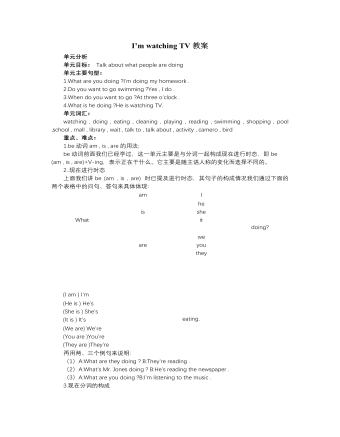
人教版新目标初中英语七年级下册I’m watching TV教案
单元分析单元目标: Talk about what people are doing 单元主要句型:1.What are you doing ?I’m doing my homework .2.Do you want to go swimming ?Yes , I do .3.When do you want to go ?At three o’clock .4.What is he doing ?He is watching TV. 单元词汇:watching , doing , eating , cleaning , playing , reading , swimming , shopping , pool ,school , mall , library , wait , talk to , talk about , activity , camero , bird 重点、难点:1.be动词am , is , are的用法;be动词前面我们已经学过,这一单元主要是与分词一起构成现在进行时态,即be (am , is , are)+V-ing,表示正在干什么。它主要是随主语人称的变化而选择不同的。2..现在进行时态上面我们讲be (am , is , are) 时已提及进行时态,其句子的构成情况我们通过下面的两个表格中的问句、答句来具体体现:3.现在分词的构成现在进行时态中be + V - ing 的构成中V-ing被称为现在分词,它的基本构成是动词原形+ing,但也有些特殊情况,下面分几类说明:(1)一般情况+ing如:read→reading,go→going,do→doing,look→looking,listen→listening,watch→watching.(2)以不发音的e结尾的词,去掉e,再加ing.如:write→writing,skate→skating,type→typing,wake→waking,make→making
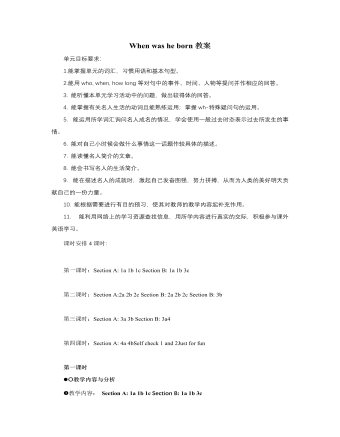
人教版新目标初中英语八年级上册When was he born教案
1.能掌握单元的词汇,习惯用语和基本句型。2.能用who, when, how long等对句中的事件、时间、人物等提问并作相应的回答。3. 能听懂本单元学习活动中的问题,做出较得体的回答。4. 能掌握有关名人生活的动词且能熟练运用;掌握wh-特殊疑问句的运用。5. 能运用所学词汇询问名人成名的情况,学会使用一般过去时态表示过去所发生的事情。 6. 能对自己小时候会做什么事情这一话题作较具体的描述。7. 能读懂名人简介的文章。8. 能会书写名人的生活简介。9. 能在描述名人的成就时,激起自己发奋图强,努力拼搏,从而为人类的美好明天贡献自己的一份力量。10. 能根据需要进行有目的预习,使其对教师的教学内容起补充作用。11. 能利用网络上的学习资源查找信息,用所学内容进行真实的交际,积极参与课外英语学习。课时安排4课时:第一课时:Section A: 1a 1b 1c Section B: 1a 1b 3c第二课时:Section A:2a 2b 2c Section B: 2a 2b 2c Section B: 3b
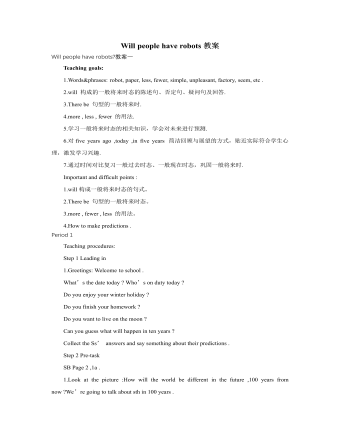
人教版新目标初中英语八年级下册Will people have robots教案
Teaching goals:1.Words&phrases: robot, paper, less, fewer, simple, unpleasant, factory, seem, etc .2.will 构成的一般将来时态的陈述句、否定句、疑问句及回答.3.There be 句型的一般将来时.4.more , less , fewer 的用法.5.学习一般将来时态的相关知识,学会对未来进行预测.6.对five years ago ,today ,in five years 简洁回顾与展望的方式,贴近实际符合学生心理,激发学习兴趣.7.通过时间对比复习一般过去时态、一般现在时态,巩固一般将来时.Important and difficult points :1.will构成一般将来时态的句式。2.There be 句型的一般将来时态。3.more , fewer , less 的用法。4.How to make predictions .Period 1Teaching procedures:Step 1 Leading in1.Greetings: Welcome to school .What’s the date today ? Who’s on duty today ?Do you enjoy your winter holiday ?Do you finish your homework ?Do you want to live on the moon ?Can you guess what will happen in ten years ?Collect the Ss’ answers and say something about their predictions .Step 2 Pre-taskSB Page 2 ,1a .1.Look at the picture :How will the world be different in the future ,100 years from now ?We’re going to talk about sth in 100 years .
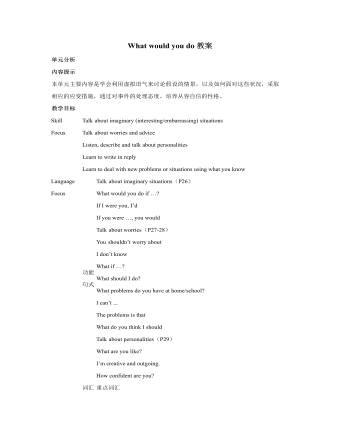
人教版新目标初中英语九年级上册What would you do教案
本课采用任务型教学法,用What would you do if you had a million dollars?这个问句,引出谈论假想情况的话题。 采用提问、启发和归纳的教法,让学生易于接受教材内容,培养学生的语言运用能力。 四、 教学过程设计 Step Ⅰ. Greet the whole class as usual. Step Ⅱ. Warming-up T: Do you have ten Yuan in your pocket? S1: No, I don’t. T: (Take out ten Yuan and give it to the student) OK, never mind. What would you do if it was yours? What would you do if you had ten Yuan? S1: I would buy snacks. T: OK, thank you. Sit down, please. (To the whole class) Just now, it was only ten Yuan. What about 100 Yuan? What would you doif you had 100 Yuan? S2: I’d buy a beautiful jacket. T: Thank you. (To the whole class) Now suppose you had a million dollars, what would you do? We know thatone dollar nearly equals eight Yuan, so that’s a large sum of money. Think it over carefully and tellme your ideas. What would you do if you had a million dollars? S3: I’d buy a big house. S4: I’d buy a sports car. S5: I’d put it in the bank. T: OK, stop here. Please look at the blackboard and guess what would I do if I had a million
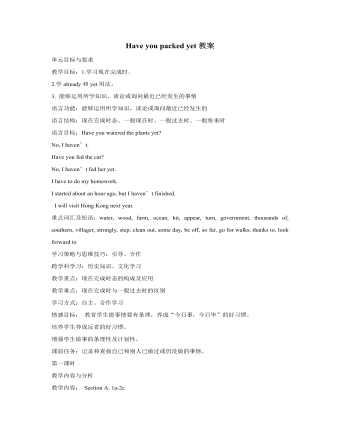
人教版新目标初中英语九年级下册Have you packed yet教案
教学目标:1.学习现在完成时。2.学already和yet用法。3. 能够运用所学知识,谈论或询问最近已经发生的事情语言功能:能够运用所学知识,谈论或询问最近已经发生的语言结构:现在完成时态、一般现在时、一般过去时、一般将来时语言目标:Have you watered the plants yet?No, I haven’t.Have you fed the cat?No, I haven’t fed her yet.I have to do my homework. I started about an hour ago, but I haven’t finished. I will visit Hong Kong next year.重点词汇及短语:water, wood, farm, ocean, hit, appear, turn, government, thousands of, southern, villager, strongly, step, clean out, some day, be off, so far, go for walks, thanks to, look forward to学习策略与思维技巧:引导、合作跨学科学习:历史知识、文化学习教学重点:现在完成时态的构成及应用教学难点:现在完成时与一般过去时的区别 学习方式:自主、合作学习 情感目标: 教育学生做事情要有条理,养成“今日事,今日毕”的好习惯。培养学生养成反省的好习惯。增强学生做事的条理性及计划性。课前任务:记录和查找自己和别人已做过或仍没做的事情。
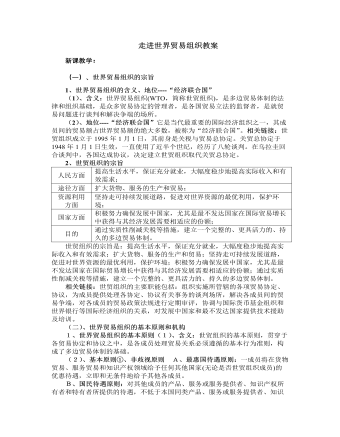
人教版高中政治选修3走进世界贸易组织教案
中国加人世贸组织承担的义务主要包括:进一步降低关税;取消非关税贸易壁垒;取消被禁止的出口补贴;开放国内市场,特别是服务市场;扩大对知识产权的保护范围;放宽和改善外资政策;增加贸易政策的透明度等。履行这些义务对中国提出了挑战。中国加入世贸组织后,享受多边、无条件、稳定的最惠国待遇和国民待遇;参与世贸组织各机构的所有会议;参与贸易政策审议,对贸易伙伴的贸易政策进行质询和监督;利用世贸组织的争端解决机制解决贸易纠纷;参与新一轮多边贸易谈判,制定多边贸易规则;享受发展中国家特有的权益。②意义:中国正充分行使这些权利,积极主动地参与、加强和发展多边贸易体制,推动建立公平、合理的国际经济新秩序,维护国家利益。相关链接:2005年7月.中国倡议的WTO小型部长级会议在大连召开,世贸组织总干事和三十多个成员的代表出席会议。
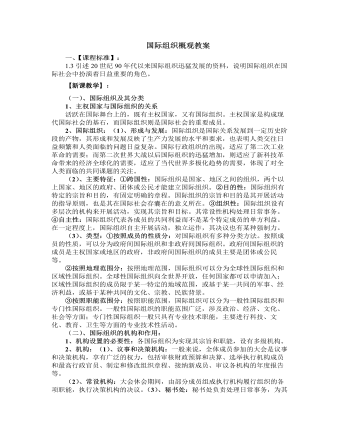
人教版高中政治选修3国际组织概观教案
4、中国积极发展与区域性国际组织的关系。中国积极发展与区域性国际组织的关系。中国与欧盟建立了领导人年度会晤机制,致力于发展全面战略伙伴关系。中国重视与非洲国家的传统友谊,与非洲联盟团结合作。中国与阿拉伯国家联盟、石油输出国组织等发展中国家组建的国际组织发展友好关系,支持它们维护自身的正当权益,并与它们共同为建立公正合理的国际政治经济新秩序而努力。新中国与国际组织关系的历史演变大致经历了三个时期。从中华人民共和国建立初期到1971年:新中国被排斥在联合国等国际组织之外,为恢复在联合国的合法席位进行了不懈的斗争。从1 9 7 1年到改革开放前:中国恢复了在联合国的合法席位,并与大批国际组织建立、恢复了友好合作关系。改革开放以来:中国恢复了在世界银行和国际货币基金组织的席位,加入了世界贸易组织、亚太经合组织等经济组织。世界银行出资兴建的希望小学小结:4个主要特征:国际组织的四个主要特征即:①跨国性、②目的性、③组织性、④自主性。

人教版高中地理选修2三峡工程对生态环境和名胜古迹的影响及对策教案
一、三峡工程的生态环境效应三峡工程的生态环境效应是指建设三峡工程对生态与环境的有利和不利影响。1、有利影响(1)防洪:(2)防治血吸虫病:(3)减轻洞庭湖淤积(4)增加枯水期流量,改善水(5)调节局部气候:(6)减轻环境污染:综上所述,三峡工程对生态环境的有利影响主要在中下游。2、不利影响及措施(1)淹没土地、耕地:水库蓄水将淹没土地、耕地。(2)加剧水土流失和环境污染:在移民开发和城市迁建过程中,处理不当可能产生新的水土流失和环境污染等问题。(3)诱发地质灾害(地震、滑坡):水库蓄水改变了原有地应力的平衡,可能诱发地震,并使库岸发生滑坡等地质灾害的可能性增大。(4)加重泥沙淤积:水库蓄水,使库区水流速度变慢,库区和库尾的泥沙淤积加重。
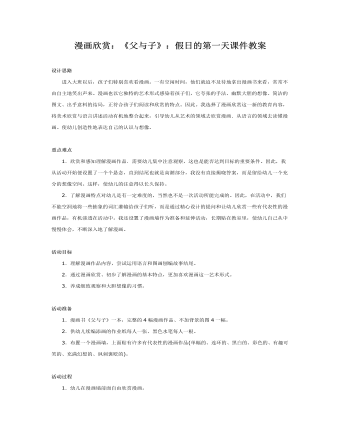
漫画欣赏:《父与子》:假日的第一天课件教案
重点难点1.欣赏和感知理解漫画作品.需要幼儿集中注意观察,这也是能否达到目标的重要条件。因此,我从活动开始便设置了一个个悬念,直到结尾也就是高潮部分,我没有直接揭晓答案,而是留给幼儿一个充分的想像空间。这样,使幼儿的注意得以长久保持。2.了解漫画特点对幼儿是有一定难度的,当然也不是一次活动所能完成的。因此,在活动中,我们不能空洞地将一些抽象的词汇灌输给孩子们听,而是通过精心设计的提问和让幼儿欣赏一些有代表性的漫画作品,有机渗透在活动中。我还设置了漫画墙作为准备和延伸活动,长期贴在教室里,使幼儿自己从中慢慢体会,不断深入地了解漫画。 活动目标1.理解漫画作品内容,尝试运用语言和图画刨编故事结尾。2.通过漫画欣赏、初步了解漫画的基本特点,更加喜欢漫画这一艺术形式。3.养成细致观察和大胆想像的习惯。 活动准备1.漫画书《父与子》一本,完整的4幅漫画作品、不加背景的图4一幅。2.供幼儿续编添画的作业纸每人一张、黑色水笔每人一根。3.布置一个漫画墙,上面贴有许多有代表性的漫画作品(单幅的、连环的、黑白的、彩色的、有趣可笑的、充满幻想的、讽刺褒贬的)。
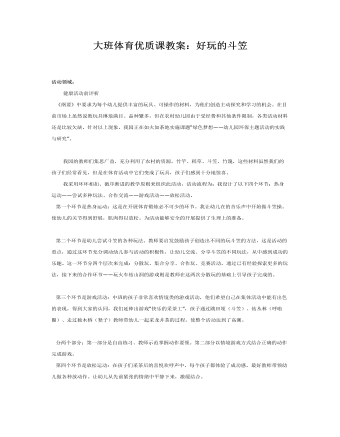
大班体育优质课教案:好玩的斗笠课件教案
我园的教师们集思广益,充分利用了农村的资源,竹竿、稻草、斗笠、竹篾,这些材料虽然我们的孩子们经常看见,但是在体育活动中它们变成了玩具,孩子们感到十分地惊喜。 我采用环环相扣、循序渐进的教学原则来组织此活动,活动流程为:我设计了以下四个环节:热身运动——尝试多种玩法、合作交流——游戏活动——放松活动。 第一个环节是热身运动:这是在开展体育锻炼必不可少的环节。我让幼儿在的音乐声中开始做斗笠操。使幼儿的关节得到舒展,肌肉得以放松。为活动能够安全的开展提供了生理上的准备。 第二个环节是幼儿尝试斗笠的各种玩法。教师要启发鼓励孩子创造出不同的玩斗笠的方法,这是活动的重点,通过这环节充分调动幼儿参与活动的积极性,让幼儿交流、分享斗笠的不同玩法,从中感到成功的乐趣。这一环节分四个层次来完成:分散玩、集合分享、合作玩、竞赛活动。通过已有经验探索更多的玩法,接下来的合作环节——玩火车钻山洞的游戏则是教师在这两次分散玩的基础上引导孩子完成的。
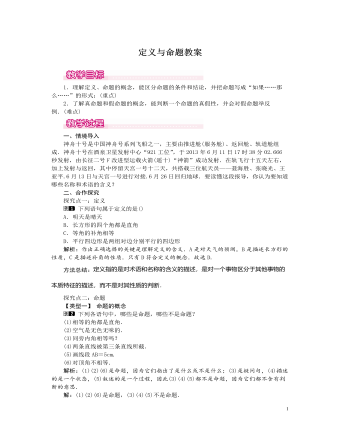
北师大初中数学八年级上册定义与命题1教案
一、情境导入神舟十号是中国神舟号系列飞船之一,主要由推进舱(服务舱)、返回舱、轨道舱组成.神舟十号在酒泉卫星发射中心“921工位”,于2013年6月11日17时38分02.666秒发射,由长征二号F改进型运载火箭(遥十)“神箭”成功发射.在轨飞行十五天左右,加上发射与返回,其中停留天宫一号十二天,共搭载三位航天员——聂海胜、张晓光、王亚平.6月13日与天宫一号进行对接.6月26日回归地球.要读懂这段报导,你认为要知道哪些名称和术语的含义?二、合作探究探究点一:定义 下列语句属于定义的是()A.明天是晴天B.长方形的四个角都是直角C.等角的补角相等D.平行四边形是两组对边分别平行的四边形解析:作出正确选择的关键是理解定义的含义.A是对天气的预测,B是描述长方形的性质,C是描述补角的性质.只有D符合定义的概念.故选D.方法总结:定义指的是对术语和名称的含义的描述,是对一个事物区分于其他事物的本质特征的描述,而不是对其性质的判断.
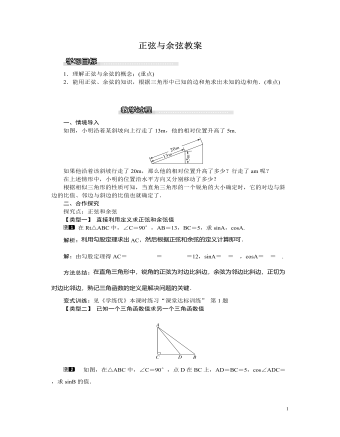
北师大初中九年级数学下册正弦与余弦1教案
解析:根据锐角三角函数的概念,知sin70°<1,cos70°<1,tan70°>1.又cos70°=sin20°,锐角的正弦值随着角的增大而增大,∴sin70°>sin20°=cos70°.故选D.方法总结:当角度在0°cosA>0.当角度在45°<∠A<90°间变化时,tanA>1.变式训练:见《学练优》本课时练习“课堂达标训练”第10题【类型四】 与三角函数有关的探究性问题在Rt△ABC中,∠C=90°,D为BC边(除端点外)上的一点,设∠ADC=α,∠B=β.(1)猜想sinα与sinβ的大小关系;(2)试证明你的结论.解析:(1)因为在△ABD中,∠ADC为△ABD的外角,可知∠ADC>∠B,可猜想sinα>sinβ;(2)利用三角函数的定义可求出sinα,sinβ的关系式即可得出结论.解:(1)猜想:sinα>sinβ;(2)∵∠C=90°,∴sinα=ACAD ,sinβ=ACAB .∵AD<AB,∴ACAD>ACAB,即sinα>sinβ.方法总结:利用三角函数的定义把两角的正弦值表示成线段的比,然后进行比较是解题的关键.
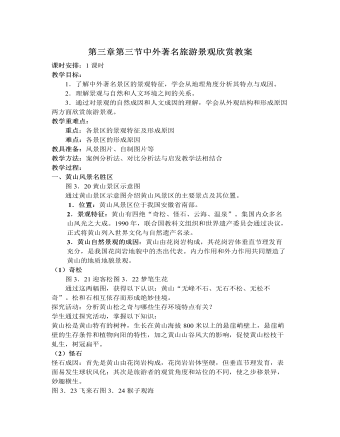
人教版高中地理选修3第三章第三节中外著名旅游景观欣赏教案
四、法国巴黎塞纳河畔的古城区城市建筑景观往往可以反映一个城市的发展过程,是城市历史的记录。巴黎的塞纳河沿岸景色优美,古老的塞纳河孕育了不可胜数的古迹,1991年巴黎的塞纳河沿岸作为文化遗产,被联合国教科文组织列入《世界遗产名录》。1.发展历史:2000年以前的巴黎只是塞纳河上西岱岛和附近几个小岛上的渔村,后来逐渐扩大,到3世纪开始有了巴黎这个名字。2.巴黎的建筑艺术和名胜古迹图3.35塞纳河风光通过图片,可以看出:塞纳河畔美丽的风景及城市的繁华。图3.36法国首都巴黎塞纳河畔的著名景点——凯旋门、艾菲尔铁塔夜景、卢浮宫外景、巴黎圣母院外景图文结合介绍巴黎塞纳河畔著名景点的位置及有关情况,重点掌握以下内容:①艾菲尔铁塔是巴黎的象征。卢浮宫原为宫殿群建筑,以收藏古典绘画和雕刻闻名。1793年改为国立美术博物馆。巴黎圣母院教堂为一典型的哥特式建筑。
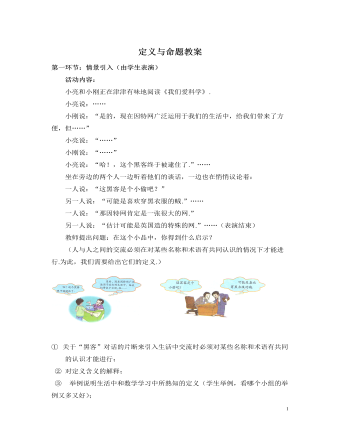
北师大初中数学八年级上册定义与命题2教案
② 命题的含义:判断一件事情的句子,叫做命题,如果一个句子没有对某一件事情作出任何判断,那么它就不是命题.活动目的:通过课后的总结,使学生对定义、命题等概念有更清楚的认识,让学生在头脑中对本节课进行系统的归纳与整理.教学效果:学生在有了前面对定义、特别是命题概念的学习后,能了解命题的结构,以及哪些是命题,使学生对命题的学习有了清楚的认识。第五环节 课后练习学习小组搜集八年级数学课本中的新学的部分定义、命题,看谁找得多.四、教学反思本节课的设计具有如下特点:(1)采用了“小品表演”的形式引入新课,意在激起学生对数学的兴趣,让学生知道,数学不是枯燥无味的。并能从表演中不同的人对“黑客”这个名词的不同理解更好地悟出“定义”的含义。
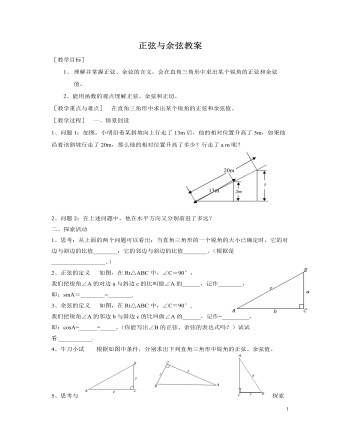
北师大初中九年级数学下册正弦与余弦2教案
[教学目标]1、 理解并掌握正弦、余弦的含义,会在直角三角形中求出某个锐角的正弦和余弦值。2、能用函数的观点理解正弦、余弦和正切。[教学重点与难点] 在直角三角形中求出某个锐角的正弦和余弦值。[教学过程] 一、情景创设1、问题1:如图,小明沿着某斜坡向上行走了13m后,他的相对位置升高了5m,如果他沿着该斜坡行走了20m,那么他的相对位置升高了多少?行走了a m呢?2、问题2:在上述问题中,他在水平方向又分别前进了多远?二、探索活动1、思考:从上面的两个问题可以看出:当直角三角形的一个锐角的大小已确定时,它的对边与斜边的比值________;它的邻边与斜边的比值________。(根据是__________________。)2、正弦的定义 如图,在Rt△ABC中,∠C=90°,我们把锐角∠A的对边a与斜边c的比叫做∠A的______,记作________,即:sinA=________=________.3、余弦的定义 如图,在Rt△ABC中,∠C=90°,我们把锐角∠A的邻边b与斜边c的比叫做∠A的______,记作=_________,即:cosA=______=_____。(你能写出∠B的正弦、余弦的表达式吗?)试试看.___________.
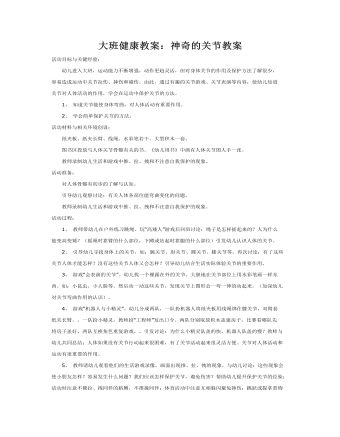
大班健康教案:神奇的关节教案
1、知道关节能使身体弯曲,对人体活动有重要作用。2、学会简单保护关节的方法。 活动材料与相关环境创设: 纸夹板、纸夹长臂、线绳、水彩笔若干、大型积木一套。 图书区投放与人体关节骨骼有关的书。《幼儿用书》中画有人体关节图人手一张。 教师录制幼儿生活和游戏中推、拉、拽和不注意自我保护的现象。 活动准备: 对人体骨骼有初步的了解与认知。 引导幼儿观察讨论:有关人体各部位能弯曲变化的问题。 教师录制幼儿生活和游戏中推、拉、拽和不注意自我保护的现象。 活动过程:1、教师带幼儿在户外练习跳绳、玩“高矮人”游戏后回班讨论:绳子是怎样摇起来的?人为什么能变高变矮?(摇绳时靠臂的什么部位,下蹲或站起时靠腿的什么部位)引发幼儿认识人体的关节。
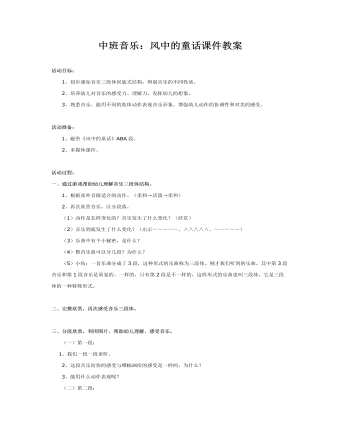
中班音乐:风中的童话课件教案
2、培养幼儿对音乐的感受力、理解力,发挥幼儿的想象。3、熟悉音乐,能用不同的肢体动作表现音乐形象,增强幼儿动作的协调性和对美的感受。 活动准备:1、磁带《风中的童话》ABA段。2、多媒体课件。 活动过程:一、通过游戏帮助幼儿理解音乐三段体结构。1、根据弦外音做适合的动作。(柔和→活泼→柔和)2、再次欣赏音乐,区分段落。 (1)动作是怎样变化的?音乐发生了什么变化?(欣赏) (2)音乐到底发生了什么变化?(出示~~~~~、∧∧∧∧∧、~~~~~) (3)乐曲中有个小秘密,是什么? (4)整首乐曲可以分几段?为什么? (5)小结:一首乐曲分成了3段,这种形式的乐曲称为三段体。刚才我们听到的乐曲,其中第3段音乐和第1段音乐是重复的、一样的,只有第2段是不一样的,这样形式的乐曲也叫三段体,它是三段体的一种特殊形式。
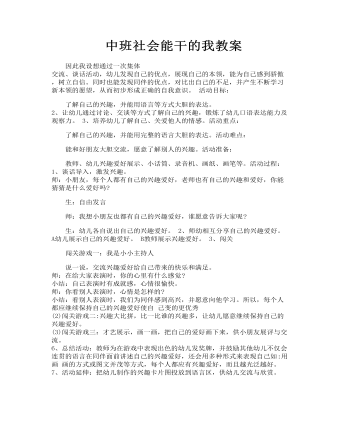
能干的小手中班教案中班社会能干的我教案
1、谈话导入,激发兴趣。 师:小朋友,每个人都有自己的兴趣爱好,老师也有自己的兴趣和爱好,你能猜猜是什么爱好吗? 生:自由发言 师:我想小朋友也都有自己的兴趣爱好,谁愿意告诉大家呢? 生:幼儿各自说出自己的兴趣爱好。 2、师幼相互分享自己的兴趣爱好。A幼儿展示自己的兴趣爱好。 B教师展示兴趣爱好。 3、闯关 闯关游戏一:我是小小主持人

大班科学课件教案:动物的尾巴2
活动过程:一、游戏“猜尾巴”1、今天本来有很多动物朋友来跟我们做游戏,但是它们很淘气,要和我们捉迷藏,让我们来找它。出示各种动物的图片(遮住身体露出尾巴)2、这些动物太粗心了,把头和身体藏了起来,可是什么露出来了?——尾巴3、哎!尾巴在外面我们就能猜出它是谁?谁来猜猜看。——这是马的尾巴,因为马尾巴是长长的,像……——这是豹子尾巴,因为它身上有斑点出来吧,我们猜出你是谁啦!小结:每种动物都有尾巴的,而这从它的尾巴的不同,我们就猜出它是谁。
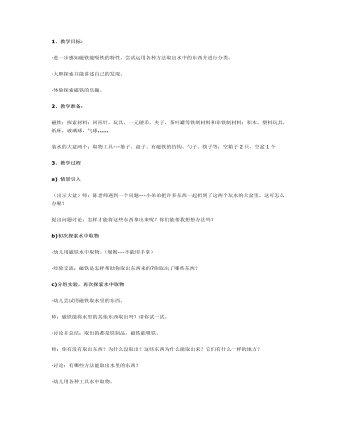
中班科学课件教案:奇妙的磁铁-水中取物
2、教学准备:磁铁;探索材料:回形针,玩具,一元硬币,夹子,茶叶罐等铁制材料和非铁制材料:积木,塑料玩具,纸杯,玻璃球,气球……装水的大盆两个;取物工具---篓子、盘子、有磁铁的钓钩、勺子、筷子等;空箱子2只,空盆1个3、教学过程a) 情景引入(出示大盆)师:陈老师遇到一个问题---小弟弟把许多东西一起扔到了这两个玩水的大盆里,这可怎么办呢? 提出问题讨论:怎样才能将这些东西拿出来呢?你们能帮我想想办法吗?

